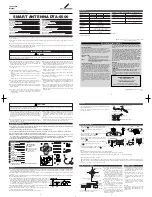
7
Saturn Bm Mk2 Marine – Technical Manual
S y s t e m D e s c r i p t i o n
S y s t e m D e s c r i p t i o n
S y s t e m D e s c r i p t i o n
The INMARSAT-B System Cont’d
Figure 3.
Communication path.
Saturn Bm
Marine
Land Earth
Station
LES
Display
Handset
Path established by
Saturn Bm terminal
via satellite
Telephone(s)
Local PABX
Telefax
Telex
Data/modem communication (option)
Saturn B
2
0
D AL 0+
L
EL NO
Public
Data
Network
Telefax
Public
Telephone
Network
PC/
modem
Public
Telex
Network
Channel numbers
All radio frequency channels used by the MES are
assigned a particular hexadecimal number which is
translated into frequencies on L-band between MES
and satellite, and to C-band between LES and satel-
lite.
Channel no.
32C8
for an MES always designates:
1660.5000 MHz transmitting frequency
1542.5000 receiving frequency
Channel Types
The Inmarsat-B System differs between physical and
functional channels. A physical channel refers to one
frequency, one carrier. Every frequency can have
several functional channels muliplexed on it. Each
functional channel is named after the originating unit.
The NCS TDM will in the initial system multiplex the
NCSC for Bulletin Boards and Call Announcement,
the NCSA for Channel Assignments and NCSI for
Interstation information to the LES on the same
physical channel. When the system expands, spot
beams and Ocean Region Registration will be intro-
duced using the functional channels NCSS and
NCRA multiplexed on the NCS TDM. The traffic on
one TDM may then be to heavy and some of the
functional channels may be moved to another NCS
TDM frequency.
The physical SCPC channels are always divided into
three functional channels. During call set up and
release the whole bandwith is used for signalling and
the functional channel is called MES-SIG/LES-SIG.
During speech or data phase, the signalling part of
the channel is called VSUB or DSUB and the service
carrying part is called MESV/LESV or MESD/LESD.
Requests and assignments
The Network Coordinating Station in each Ocean
Region continually transmits to the MESs within its
region on the NCS Common Signalling Channel
(NCSC).
When selecting a particular Ocean Region, the MES
automatically tunes its receiver to the NCSC fre-
quency, and awaits System Information from the
NCS.
The System Information (Bulletin Board) includes
available NCS/LES channel frequencies, location of
satellites, operational status, etc.
When the NCS sends a Call Announcement, detail-
ing the channel to which the MES should tune to
receive the call.
When the MES user dials a subscriber’s international
telephone number, the MES transmits an Access
Request to the NCS via the LES, and awaits a Chan-
nel Assignment from the NCS.
Telephone communication
For telephone communication a Frequency Division
Multiple Access (FDMA) is used, in a Single Channel
Per Carrier (SCPC) system. The voice communica-
tion occupies two (unpaired) channel frequencies.
The telephone channels are controlled by NCS which
assigns a free channel upon request. When a chan-
nel has been assigned it is controlled by LES until
end of call.
Facsimile communication
The Saturn Bm telephone ports may be configured
for telefax communication. The transmission is
telefax only, and is performed at a rate of 9.6 kbps.
Telefaxes without keypad may be connected via an
adapter.
Data communication
The data service allows the Saturn Bm user to com-
municate at up to 56/64 kbps, via the public switched
network, to fixed modems and data terminals.
-- 10 of 30
LRC Prüfung











































